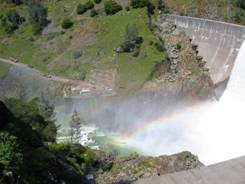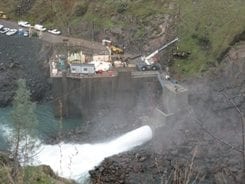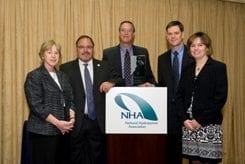Narrows 2 Hydro Power Plant Flow Bypass Project

A rainbow emerges from Engelbright Dam and the Narrows 2 Powerhouse. The U.S. Army Corps of Engineers constructed the dam in 1941 to protect the lower part of the Yuba River from sediment and debris.
Summary
The Yuba County Water Agency’s Narrows 2 Flow Bypass demonstrates how utilities can work with state and federal organizations and other stakeholders to protect threatened species and enhance their own operations. The $12.2 million, 18-month effort overcame dam safety, engineering, scheduling, operation, and environmental challenges. Today the project maintains optimum flow and water temperature to sustain valuable fisheries.
Through this project, Yuba County created a way to protect threatened spring-run Chinook salmon and help to preserve the last self-sustaining wild steelhead population in California’s Central Valley. By maintaining a steady flow of cold water, even during emergencies, the project benefits fish-spawning grounds downstream on the Yuba River.

A bypass system was designed and installed at the Narrows 2 Powerhouse. Completed in January 2007, the bypass improved reliability by automatically maintaining flow and water temperature in the Yuba River during emergencies.
Background
The Yuba River is home to several threatened species. Aside from supporting the Central Valley’s last self-sustaining wild steelhead population, the river has an extensive spawning area downstream of Englebright Dam that supports spring-run Chinook salmon and steelhead trout, both of which are listed as threatened under the Endangered Species Act. Maintaining water levels and temperature conditions, especially during spawning season, is critical to the survival of these species.
Although the Narrows 2 power plant incorporates features that provide cold water releases and water-level management options that benefit downstream fisheries, these features do not function during plant or transmission-system outages. Water levels can drop and temperatures can rise at such times, adversely affecting the spawning grounds. Yuba County built the Narrows 2 Flow Bypass project to avoid this by automatically maintaining flow and temperature during emergencies.

From left to right: NHA President Leslie Eden, Yuba County Water Authority President John Nicoletti, Steve Onken, Yuba County Water Authority General Manager Curt Aiken, and Julie Smith-Galvin of Brookfield Power.
Challenge
There were many challenges in retrofitting the bypass to the existing dam and powerhouse. They ranged from design to safety and included the need to lessen the environmental footprint during construction.
Hydraulic design – Developing a design for the bypass that would not adversely affect the hydraulics and operation of the existing hydroelectric power plant.
Dam Safety – Avoiding structural damage to Englebright Dam and Narrows Powerhouse.
Rock Conditions – Rock at the site was a very hard quartzite that was six times stronger than concrete, which made drilling and excavation very difficult.
Personnel Safety – The worksite is adjacent to the river channel downstream of an operating spillway that generates continuous spray during high river flow conditions.
Construction Access – Because of concerns about entrainment of angular crushed rock into downstream spawning gravels no construction roads were permitted in the river channel.
Operations – Minimizing impacts during construction on water releases from Englebright Dam and power generation operations at Narrows 2 Powerhouse.
Schedule – Construction work had to be completed within a 12-week power plant maintenance outage.
Environmental – Adverse impacts to anadromous fish and water quality because of blasting, rock excavation and other construction operations were unacceptable.
Construction Risk – Developing a construction agreement to deliver the project within a specific cost and schedule given the high construction risks involved.
Innovation
In meeting the challenge of this project, Yuba County Water Agency took some innovative approaches.
Hydraulic design – The design of the bypass connection was tested in a hydraulic laboratory to ensure that its hydraulic design was feasible.
Construction Access – To protect anadromous fish, the tunnel and outlet structure were constructed using a crane instead of using a temporary construction road. This option lessened the risk that washout of the road could have affected downstream spawning habitat.
Controlled Blasting – Careful planning and use of controlled blasting techniques allowed construction of a 30 foot deep excavation for the bypass valve outlet structure adjacent to the powerhouse. It also allowed construction of the new bypass tunnel within 5 feet of the existing power tunnel while the tunnel and power plant were operating. In doing so, the project was able to maintain operations during most of the construction, serving local citizens with clean, reliable power.
Incentive Based Construction Contract – A Fixed Price construction contract was developed which included incentives for timely performance and avoidance of construction claims.
Communications – An interactive collaborative website was used to manage the project and provide 24/7 access to project information. During the latter part of the power plant outage the construction team worked 24/7.
Results
The project was successfully implemented without adversely affecting downstream fish spawning habitat, providing a lasting improvement for fish habitat and helping to protect important fish species for future generations. In addition, the project resulted in significant accomplishments.
Personnel Safety – The project was completed safely without lost time accidents.
Dam Safety – State-of-the-art monitoring of rock vibration during blasting operations succeeded in ensuring that there was no damage to Englebright Dam or Narrows 2 Powerhouse.
Schedule – Despite delayed delivery of large diameter valve equipment from Europe and installation challenges that required a one month extension of project shutdown, the project was successfully completed in 18 months.
Cost – The project was completed for a construction cost of $12.2 million. Funding sources included $300,000 from USFWS Anadromous Fish Program, $8,535,567 from CALFED, and $3,416,657 from Yuba County Water Agency.
Stakeholder Quotes
During a tour of the completed project in April 2007 held for resource agencies, stakeholders, and the public the following two quotes lauding the project were reported in local newspapers.
“The valve will improve the reliability of fish reproduction by keeping enough cool water flowing over the gravel where fish lay their eggs.” — Ryan Broddrick, Director, California Fish and Game
“It’s an exciting development. This should improve strandings and should be an overall improvement for the Yuba salmon.” — Jason Rainey, Executive Director, South Yuba River Citizens League


